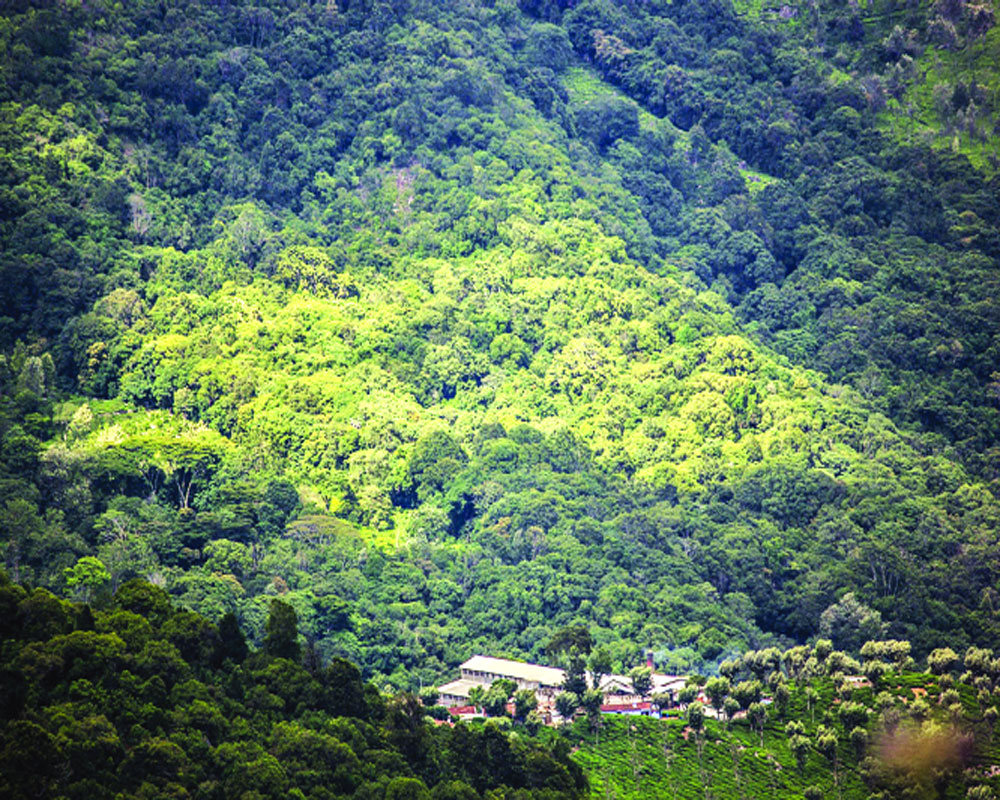‘Sacred groves’ are fast disappearing in the country due to the erosion of traditional belief system which helped conserve them
Vayalar Ramavarma, a leading poet had penned down some of the eternal romantic and revolutionary poems. ‘Puzhakal’, ‘Malakal’, ‘Poovanangal’, ‘Bhumikku Kittiya Sthreedhanangal’ (English for Rivers, Mountains, Gardens, are the dowries bestowed on Mother Earth) was a song he authored for the 1969 blockbuster film ‘Nadi’ based on a story set on the banks of Periyar, Kerala’s longest river. Vayalar wrote these lyrics much before the environmentalists and ecologists hogged the limelight.
Almost six decades later, what we see is the inhabitants of planet Earth, especially those in Bharath, squandering the entire dowry received by Mother Earth. India, which had nearly 40 per cent forest cover way back in the 1950s has destructed forever the evergreen forests, especially the Rain Forests in the country under the pretext of development. The sad truth is that there is neither forest nor development. Politicians plant hundreds of thousands of saplings on the birth anniversary of their leaders. But once the TV cameras and news photographers leave the spot, the saplings end up in dustbins! There is no system in place to take care of the saplings. If the number of saplings planted by the AIADMK cadres in Tamil Nadu on the occasion of party supremo Jayalalithaa’s birth anniversaries is any indication, the entire State would have become an eternal forest by this time.
The forest wealth of India is giving way to development under the pretext of infrastructure development, urbanisation, industrialisation and commercialisation. A group of parliament members from Kerala are agitating for a railway line to Sabarimala, the holy shrine atop the verdant Western Ghats which is open only during the festival season from November to January. The proposed rail track is all set to destroy hectares of forest which is known as sacred groves. B V Kumar, the former chief of the Directorate of Revenue Intelligence, popularly addressed as the country’s super sleuth, who has undertaken a trip to the Western Ghats by foot, found to his horror that high-quality cannabis is being cultivated atop the Anamalai Hills and it is to facilitate the transport of the “stuff” to Kochi and other places that the railway track is being demanded.
In addition to the destruction of forests, the plunderers and looters are out to destroy the sacred groves (mini forests) maintained and looked after by the local communities across the country. Sacred Groves are an important heritage of the country and can be seen from Surat to Silchar and Kashmir to Kanyakumari. These mini forests have an area of two to 25 hectares and are the repositories of the natural biodiversity of the region. These forests boast of rare medical plants, shrubs and trees in addition to other flora and fauna. Some of the groves are on the periphery of towns and cities. The local inhabitants literally adored and worshipped these groves and had declared them as no-go areas. Children were told stories linking these mini forests .
But an in-depth study by the Chennai-based CPR Environmental Education Centre, headed by Dr Nanditha Krishna has found that the sacred groves are being destroyed at an alarming rate by our own brethren. The groves are a tribute to the local deities or tree spirits and the local population has installed clay statues of the Gods whom they worship as their saviours.
“The degree of sanctity accorded to the sacred groves varies from one area to another. In some forests, even the dry foliage and fallen fruits are not touched. People believe that any kind of disturbance will offend the local deity, causing diseases, natural calamities or failure of crops. For example, the Garo and the Khasi tribes of north-eastern India prohibit any human interference in the sacred groves. In other places, deadwood or dried leaves may be picked up, but the live tree or its branches are never cut. For example, the Gonds of central India prohibit the cutting of a tree but allow fallen parts to be used,” writes Dr. Naditha Krishna in her research paper. Dr Krishna, the great-granddaughter of C P Ramaswamy Iyer, lives in her ancestral home named “The Grove”.
The groves are often associated with ponds, streams or springs, which support the water requirements of the local people. The vegetative cover helps in the recharging aquifers. The vegetation cover of the sacred groves improves the soil stability of the area and prevents soil erosion. Although there has been no comprehensive study of sacred groves in the entire country, experts estimate the total number of sacred groves in India could be in the range of 100,000 – 150,000.
The threats to the groves vary from one region to the other and even from one forest to the other. However, the common threats identified are the disappearance of the traditional belief systems, which were fundamental to the concept of sacred forests. These systems and their rituals are now considered mere superstition Encroachment has led to the shrinkage of some of the largest forests in the country. Many forests are suffering due to ‘Sanskritisation’ or the transformation of the primitive forms of nature worship into formal temple worship. Invasion by exotic weeds such as Eupatorium odoratum, Lantana camara and Prosopis juliflora is a serious threat to some groves. One need not sacrifice the scientific temper and secularist credentials to protect these groves. But consider them as armed guards of nature to save the land.
(The writer is special correspondent with The Pioneer; views are personal)

























